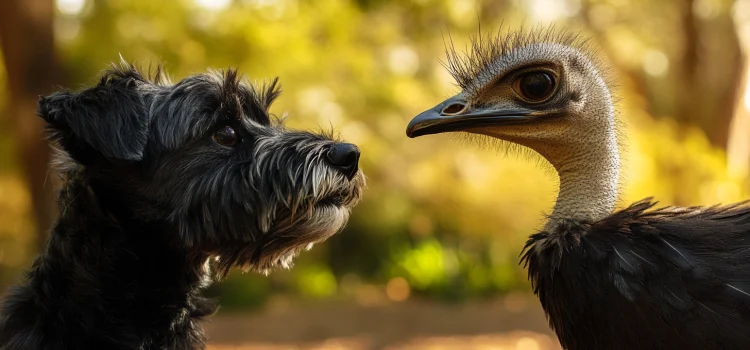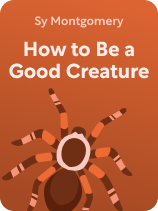

This article is an excerpt from the Shortform book guide to "How to Be a Good Creature" by Sy Montgomery. Shortform has the world's best summaries and analyses of books you should be reading.
Like this article? Sign up for a free trial here.
What sparked Sy Montgomery’s passion for animals? What type of dog did she have growing up?
Sy Montgomery explains that she was drawn to animals and nature since she was a child growing up as a general’s daughter on different US Army bases in the 1960s. Several key relationships with animals fostered her interest in the natural world, leading her to find her calling as a nature writer.
Below, we’ll look more closely at two connections she made: with her childhood dog and with wild emus on her first research expedition.
Molly the Scottish Terrier
Montgomery credits her childhood dog, a Scottish terrier named Molly, for sparking her passion for animals, the natural world, and her fascination with wildness. From the time she was a puppy, Molly embodied the traits Scotties are known for: She was independent, difficult to train, and an avid, confident hunter despite her small size.
(Shortform note: Scottish terriers like Molly have independent, strong-willed personalities because they were bred to hunt animals such as foxes, badgers, and rats. This means they generally have a strong prey drive, so they’re likely to chase any small animals they see. Because of this, some experts recommend keeping them on a leash or supervising them in a fenced yard whenever they’re outside. This will help to keep them and other animals around them safe.)
While growing up, Montgomery looked to Molly as a role model, as another child might view an older sibling. Montgomery spent her childhood closely observing Molly and admiring everything about her, from her self-sufficiency to her strong teeth. She watched Molly chase small animals, use her keen sense of smell to discover hidden things, and roam freely. This admiration and interest in Molly’s wildness encouraged Montgomery to engage with other animals and their unique perspectives.
| What Pets Can Teach Children As Montgomery experienced, close relationships with pets can help children develop many positive traits. This is especially true for children who don’t have siblings to look up to. Traits children can develop include the following: Empathy: Taking care of a pet can teach children how to empathize with other creatures and learn the nuances of nonverbal communication. Independence: Pets can also increase an only child’s independence. When parents pay attention to a pet as well as their child, it shows the child that they’re not the center of everything, and they can do things by themselves. Responsibility: Children—especially those without siblings—can learn how to be responsible by taking care of a pet. They learn what it means to have another being rely on them, and they can develop a sense of pride in helping someone else. |
The Australian Emus
Molly sparked Montgomery’s passion for animals and the natural world, but it was Montgomery’s bond with three Australian emus that solidified her decision to work with animals and write about them for a living. After working in journalism for several years, Montgomery traveled to Australia with a nonprofit organization that hosted scientific expeditions for nonscientists like herself.
(Shortform note: If you’re interested in traveling and conducting research as a nonscientist like Montgomery did, there are still organizations that host similar trips. For example, Earthwatch pairs scientists with volunteers on trips with projects related to climate change, ocean health, and wildlife and ecosystems.)
In the two weeks she spent working with a conservation biologist, Montgomery developed such a passion for studying and being present with animals in their natural habitats that she decided to quit her job in the US and return to Australia. Montgomery began independently researching the behaviors of three young emus she encountered while assisting with other projects.
(Shortform note: How do you know when it’s time to quit one career path and pursue one you’re more passionate about, as Montgomery did? Some experts suggest that it’s best to start slowly by spending evenings and weekends on your passion project. This way, you still have money coming in while you’re turning your hobby into something more lucrative. Then, you can increase your hours by working on your new venture part-time. Build a list of contacts in whatever field your passion project falls under, and develop any skills you’re missing. Finally, build up your savings as much as possible so you have something to fall back on when you officially leave your current job.)
Montgomery followed the emus every day. As she spent more time with them, she witnessed aspects of their unique personalities, such as the enjoyment they seemed to get from teasing a tied-up dog. By the time she had to leave the emus and go back to the US, Montgomery realized that she never wanted to return to a regular office job. The enjoyment and calm she got from spending time with the emus inspired her to travel, meet more animals, and write about her experiences with them.
(Shortform note: As Montgomery’s experience suggests, emus typically have friendly, curious dispositions. However, as with any wild animal, you should approach them with caution—though they rarely attack humans, a kick from their sharp-clawed feet can cause serious, life-threatening injuries.)

———End of Preview———
Like what you just read? Read the rest of the world's best book summary and analysis of Sy Montgomery's "How to Be a Good Creature" at Shortform.
Here's what you'll find in our full How to Be a Good Creature summary:
- Lessons about life and love that naturalist Sy Montgomery learned from animals
- How to appreciate animals and people in new ways
- How to be more curious, compassionate, friendly, and loving






